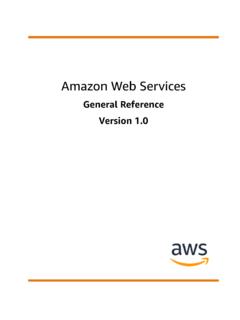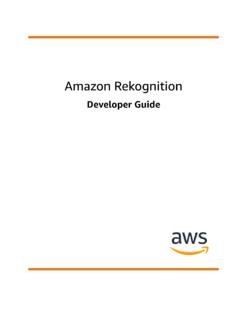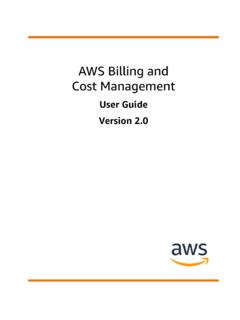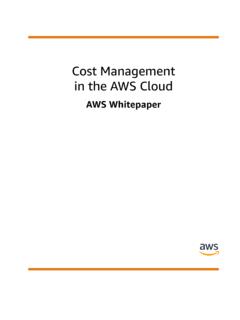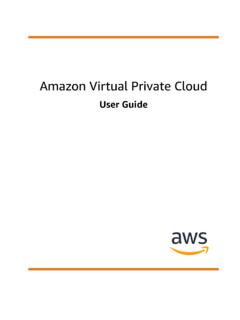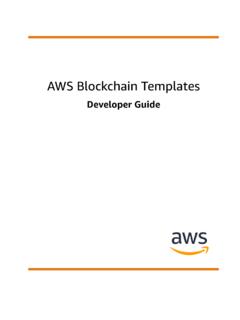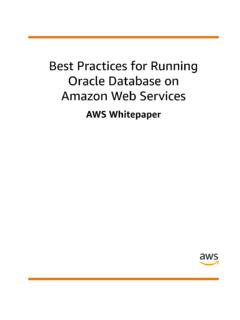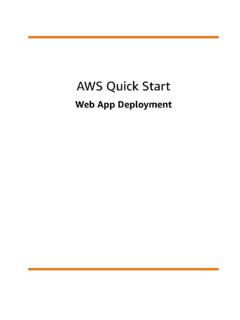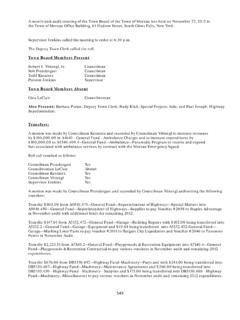Transcription of Jenkins on AWS - AWS Whitepaper
1 Jenkins on AWSAWS WhitepaperJenkins on AWS AWS WhitepaperJenkins on AWS: AWS WhitepaperCopyright 2018 Amazon Web Services, Inc. and/or its affiliates. All rights 's trademarks and trade dress may not be used in connection with any product or service that is not Amazon's, in any mannerthat is likely to cause confusion among customers, or in any manner that disparages or discredits Amazon. All other trademarks notowned by Amazon are the property of their respective owners, who may or may not be affiliated with, connected to, or sponsored on AWS AWS WhitepaperTable of ContentsJenkins on AWS .. 1 Abstract .. 1 Introduction .. 1 Why CI/CD? .. 1 Why Use Jenkins ?
2 2 Deploying Jenkins on AWS .. 3 Amazon VPC .. 3 Traditional Deployment .. 3 Overview of Jenkins Architecture .. 3 Strategies for Jenkins Worker Node Deployments .. 3 Strategies for Jenkins Master Deployments .. 4 Architecting for High Availability .. 5 Resource Considerations for Right-Sizing Your Jenkins Master .. 6 Installation.. 7 Security Considerations .. 8 Worker Nodes .. 10 Decoupling Configuration from Our Jenkins Installation .. 12 Best practices .. 15 Containerized Deployment .. 16 Overview of Container Technology .. 16 Overview of Container-based Jenkins .. 16 Amazon ECS .. 17 Implementation.. 18 Security Considerations.
3 19 Using AWS CodeBuild with Jenkins .. 20 AWS CodeBuild .. 20 Jenkins and AWS CodeBuild Integration .. 20 Jenkins Integration.. 22 AWS Integration .. 22 Other Notable Plugins.. 22 Solution 1: Vanilla CI/CD Pipeline .. 23 Goal.. 23 Services Used .. 23 Architecture Diagram.. 23 Explanation.. 23 Solution 2: Container Pipeline.. 24 Goal.. 24 Services Used .. 24 Architecture Diagram.. 24 Explanation.. 24 Solution 3: Mobile Application.. 25 Goal.. 25 Services Used .. 25 Architecture Diagram.. 25 Explanation.. 25 Solution 4: Serverless Code Management .. 25 Goal.. 26 Services Used .. 26 Architecture Diagram.
4 26 Explanation.. 26 Solution 5: Security Automation Framework .. 26 Goal.. 27 Services Used .. 27 Architecture Diagram Example 1 .. 27iiiJenkins on AWS AWS WhitepaperExplanation Example 1.. 27 Architecture Diagram Example 2 .. 28 Explanation Example 2.. 28 Conclusion.. 29 Document Details.. 30 Contributors.. 30 Document History .. 30 Resources .. 31 AWS Glossary .. 32ivJenkins on AWS AWS WhitepaperAbstractJenkins on AWSP ublication date: May 2017 (Document Details (p. 30))AbstractAlthough there are many ways to deploy the Jenkins open-source automation server on Amazon WebServices (AWS), this Whitepaper focuses on two specific approaches.
5 First, the traditional deploymenton top of Amazon Elastic Compute Cloud (Amazon EC2). Second, the containerized deployment thatleverages Amazon EC2 Container Service (Amazon ECS). These approaches enable customers to takeadvantage of the continuous integration/ continuous delivery (CI/CD) capabilities of Jenkins . Usingan extensive plugin system, Jenkins offers options for integrating with many AWS services and canmorph to fit most use cases ( , traditional development pipelines, mobile development, securityrequirements, etc.).IntroductionWhy CI/CD?To understand the continuous integration/continuous delivery (CI/CD) model that Jenkins uses, let sstart with understanding its underlying drivers.
6 Since the early 2000s, the advent of fast-paced, iterativemethodologies such as agile has shifted the thinking about software development. In this new paradigm,product teams push their work to customers as quickly as possible so that they can collect feedback andimprove upon the previous iteration of their products. Concepts such as minimum viable product (MVP),release candidate, velocity, etc. are all derived from these new approaches. In contrast, product teamsusing older paradigms like waterfall development might not hear back from customers for months and,quite often, not until the product is following figure illustrates the high-level phases of product development:Figure: High-level product development phasesThe order and length of these phases varies depending on which development models is used ( ,waterfall, v-model, scrum, etc.)
7 Continuous IntegrationContinuous integration (CI) is a software development practice in which developers regularly mergetheir code changes into a central repository, after which automated builds and tests are run. Continuousintegration most often refers to the build or integration stage of the software release process and entailsboth an automation component ( , a CI or build service) and a cultural component ( , learning tointegrate frequently). The key goals of continuous integration are to find and address bugs quicker,improve software quality, and reduce the time it takes to validate and release new software on AWS AWS WhitepaperWhy Use Jenkins ?The basic challenges of continuous integration include maintaining a single source code repository,automating builds (and building fast), and automating testing.
8 Additional challenges include testingon a clone of the production environment, providing visibility of the process to the team, and allowingdevelopers to obtain the latest version easily. The goal of this Whitepaper is to show you how usingJenkins on AWS is a strategy fit to address these CI Delivery and DeploymentContinuous delivery (CD) is a software development practice where code changes are automatically built,tested, and prepared for production release. It expands upon continuous integration by deploying allcode changes to a testing environment, a production environment, or both after the build stage has beencompleted. When continuous delivery is properly implemented, developers always have a deployment-ready build artifact that has passed through a standardized test process.
9 With continuous deployment,revisions are deployed to a production environment automatically without explicit approval from adeveloper, making the entire software release process automated. This, in turn, allows for the product tobe in front of its customers early on, and for feedback to start coming back to the development Use Jenkins ? Jenkins is a very popular product among AWS customers who want to automate their CI/CD pipelines. It accomplishes all of the phases described in the previous section. It integrates very well across languages, platforms, and operating systems. It s open-source works well on AWS and with AWS because it s available on the AWS Marketplace, it s widelydocumented, and it s very well integrated.
10 Additionally, Jenkins plugins are available for a number ofAWS services. The rest of this Whitepaper discusses some of those plugins and what they allow ourcustomers to the Jenkins official website:"The leading open source automation server, Jenkins provides hundreds of plugins to supportbuilding, deploying and automating any project." on AWS AWS WhitepaperAmazon VPCD eploying Jenkins on AWSIn this section we discuss two approaches to deploying Jenkins on AWS. First, you could use thetraditional deployment on top of Amazon Elastic Compute Cloud (Amazon EC2). Second, you coulduse the containerized deployment that leverages Amazon EC2 Container Service (Amazon ECS).
